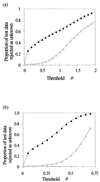Identification of phytoplankton from flow cytometry data by using radial basis function neural networks
- PMID: 10508067
- PMCID: PMC91585
- DOI: 10.1128/AEM.65.10.4404-4410.1999
Identification of phytoplankton from flow cytometry data by using radial basis function neural networks
Abstract
We describe here the application of a type of artificial neural network, the Gaussian radial basis function (RBF) network, in the identification of a large number of phytoplankton strains from their 11-dimensional flow cytometric characteristics measured by the European Optical Plankton Analyser instrument. The effect of network parameters on optimization is examined. Optimized RBF networks recognized 34 species of marine and freshwater phytoplankton with 91. 5% success overall. The relative importance of each measured parameter in discriminating these data and the behavior of RBF networks in response to data from "novel" species (species not present in the training data) were analyzed.
Figures



References
-
- Balfoort H W, Snoek J, Smits J R M, Breedveld L W, Hofstraat J W, Ringelberg J. Automatic identification of algae: neural network analysis of flow cytometric data. J Plankton Res. 1992;14:575–589.
-
- Boddy L, Morris C W, Wilkins M F, Tarran G A, Burkill P H. Neural network analysis of flow cytometric data for five marine phytoplankton groups. Cytometry. 1994;15:283–293. - PubMed
-
- Boddy, L., and C. W. Morris. Artificial neural networks for pattern recognition. In A. Fielding (ed.), Machine learning methods for ecological applications. Kluver, London, United Kingdom, in press.
-
- Carr M R, Tarran G A, Burkill P H. Discrimination of marine phytoplankton species through the statistical analysis of their flow cytometric signatures. J Plankton Res. 1996;18:1225–1238.
-
- Cunningham A, Buonaccorsi G A. Narrow angle forward light scattering from individual algal cells: implications for size and shape discrimination in flow cytometry. J Plankton Res. 1992;14:223–234.
Publication types
MeSH terms
LinkOut - more resources
Full Text Sources

